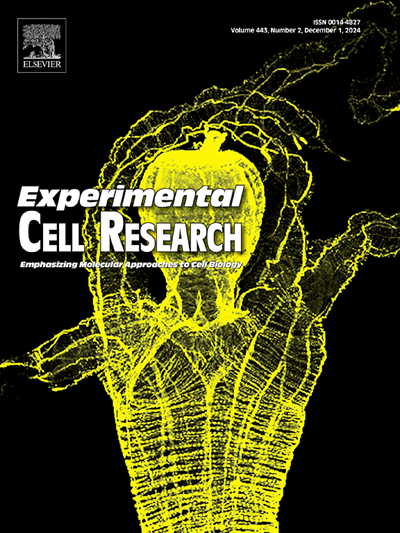APEX1的沉默通过app介导的p53/xCT信号激活引发透明细胞肾细胞癌的铁下垂。
IF 3.3
3区 生物学
Q3 CELL BIOLOGY
引用次数: 0
摘要
背景:APEX1 (APEX1)参与调节多种癌细胞的增殖、侵袭、迁移和其他恶性进展。然而,其在透明细胞肾细胞癌(ccRCC)中的机制尚不清楚。方法:应用UALCAN数据库预测APEX1在ccRCC中的表达。CCK-8、菌落形成、EdU、伤口愈合、transwell和流式细胞术检测用于评估细胞增殖、迁移、侵袭和细胞周期。western blot检测细胞周期蛋白和铁下垂生物标志物的表达。用检测试剂盒检测细胞中Fe2+、ROS、MDA、SOD、GSH水平。荧光探针检测细胞内脂质过氧化水平。通过Co-IP验证APEX1与淀粉样蛋白前体蛋白(APP)的结合。western blot检测p53/xCT通路蛋白的表达。结果:APEX1在ccRCC组织中高表达,且与不良预后呈正相关。APEX1的沉默抑制了Caki-1细胞的增殖、侵袭、迁移,诱导细胞周期阻滞。这种沉默也导致细胞内Fe2+、脂质过氧化和ROS水平升高,从而诱导细胞铁下垂。APEX1能与APP结合,且两者的表达呈负相关。APP的沉默逆转了APEX1沉默对Caki-1细胞增殖、侵袭、迁移和细胞周期的抑制作用。此外,APEX1通过与APP结合上调p53/xCT信号,从而促进铁下垂。结论:综上所述,APEX1的沉默可能通过app介导的p53/AKT信号激活,促进铁凋亡并抑制ccRCC的恶性进展,为ccRCC的治疗提供了一种新的治疗策略。本文章由计算机程序翻译,如有差异,请以英文原文为准。
Silencing of APEX1 triggers ferroptosis in clear cell renal cell carcinoma via APP-mediated activation of p53/xCT signaling
Background
Apurinic/apyrimidinic endodeoxyribonuclease 1 (APEX1) is involved in regulating the proliferation, invasion, migration, and other malignant progression of various cancer cells. However, its mechanism in clear cell renal cell carcinoma (ccRCC) remains unclear.
Methods
UALCAN database was performed to predict APEX1 expression in ccRCC. CCK-8, colony formation, EdU, wound healing, transwell, and flow cytometry assays were used to assess cell proliferation, migration, invasion, and cell cycle. Expressions of cell cycle proteins and ferroptosis biomarkers were detected by Western blot. The levels of Fe2+, ROS, MDA, SOD, and GSH in cells were detected by assay kits. Fluorescent probe was used to monitor the intracellular lipid peroxidation level. The binding of APEX1 and amyloid precursor protein (APP) was validated by Co-IP. The expressions of p53/xCT pathway proteins were examined by Western blot.
Results
The results showed that APEX1 was highly expressed in ccRCC tissues and positively correlated with poor prognosis. Silencing of APEX1 inhibited the proliferation, invasion, and migration of Caki-1 cells and induced cell cycle arrest. This silencing also led to increased levels of intracellular Fe2+, lipid peroxidation, and ROS, thereby inducing cell ferroptosis. APEX1 could bind to APP, and their expressions were negatively correlated. Silencing of APP reversed the inhibition effects of APEX1 silencing on proliferation, invasion, migration, and cell cycle in Caki-1 cells. Moreover, silencing of APEX1 up-regulated the p53/xCT signaling by binding to APP, thereby promoting ferroptosis.
Conclusion
In summary, silencing of APEX1 promotes ferroptosis and inhibits the malignant progression of ccRCC, potentially through APP-mediated activation of p53/AKT signaling, providing a novel therapeutic strategy for ccRCC treatment.
求助全文
通过发布文献求助,成功后即可免费获取论文全文。
去求助
来源期刊

Experimental cell research
医学-细胞生物学
CiteScore
7.20
自引率
0.00%
发文量
295
审稿时长
30 days
期刊介绍:
Our scope includes but is not limited to areas such as: Chromosome biology; Chromatin and epigenetics; DNA repair; Gene regulation; Nuclear import-export; RNA processing; Non-coding RNAs; Organelle biology; The cytoskeleton; Intracellular trafficking; Cell-cell and cell-matrix interactions; Cell motility and migration; Cell proliferation; Cellular differentiation; Signal transduction; Programmed cell death.
 求助内容:
求助内容: 应助结果提醒方式:
应助结果提醒方式:


